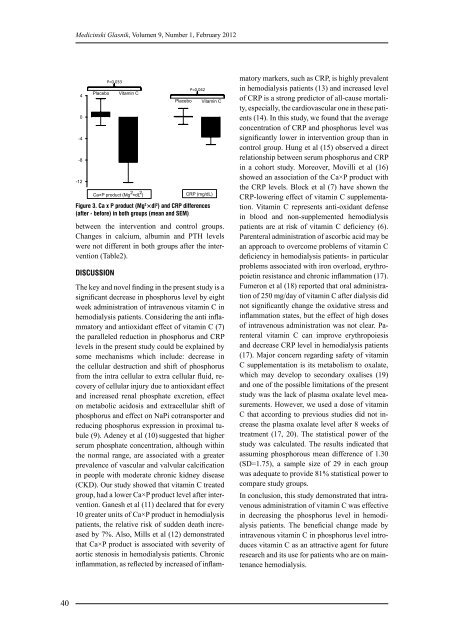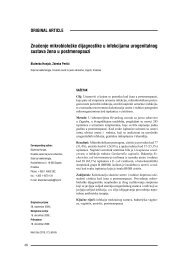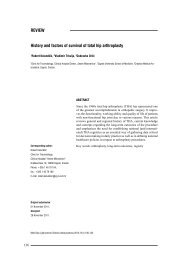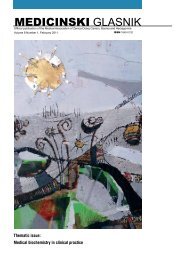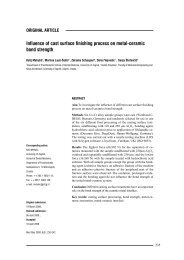MEDICINSKI GLASNIK
MEDICINSKI GLASNIK
MEDICINSKI GLASNIK
Create successful ePaper yourself
Turn your PDF publications into a flip-book with our unique Google optimized e-Paper software.
40<br />
Medicinski Glasnik, Volumen 9, Number 1, February 2012<br />
Figure 3. Ca x P product (Mg 2 ×dl 2 ) and CRP differences<br />
(after - before) in both groups (mean and SEM)<br />
between the intervention and control groups.<br />
Changes in calcium, albumin and PTH levels<br />
were not different in both groups after the intervention<br />
(Table2).<br />
DISCUSSION<br />
The key and novel finding in the present study is a<br />
significant decrease in phosphorus level by eight<br />
week administration of intravenous vitamin C in<br />
hemodialysis patients. Considering the anti inflammatory<br />
and antioxidant effect of vitamin C (7)<br />
the paralleled reduction in phosphorus and CRP<br />
levels in the present study could be explained by<br />
some mechanisms which include: decrease in<br />
the cellular destruction and shift of phosphorus<br />
from the intra cellular to extra cellular fluid, recovery<br />
of cellular injury due to antioxidant effect<br />
and increased renal phosphate excretion, effect<br />
on metabolic acidosis and extracellular shift of<br />
phosphorus and effect on NaPi cotransporter and<br />
reducing phosphorus expression in proximal tubule<br />
(9). Adeney et al (10) suggested that higher<br />
serum phosphate concentration, although within<br />
the normal range, are associated with a greater<br />
prevalence of vascular and valvular calcification<br />
in people with moderate chronic kidney disease<br />
(CKD). Our study showed that vitamin C treated<br />
group, had a lower Ca×P product level after intervention.<br />
Ganesh et al (11) declared that for every<br />
10 greater units of Ca×P product in hemodialysis<br />
patients, the relative risk of sudden death increased<br />
by 7%. Also, Mills et al (12) demonstrated<br />
that Ca×P product is associated with severity of<br />
aortic stenosis in hemodialysis patients. Chronic<br />
inflammation, as reflected by increased of inflam-<br />
matory markers, such as CRP, is highly prevalent<br />
in hemodialysis patients (13) and increased level<br />
of CRP is a strong predictor of all-cause mortality,<br />
especially, the cardiovascular one in these patients<br />
(14). In this study, we found that the average<br />
concentration of CRP and phosphorus level was<br />
significantly lower in intervention group than in<br />
control group. Hung et al (15) observed a direct<br />
relationship between serum phosphorus and CRP<br />
in a cohort study. Moreover, Movilli et al (16)<br />
showed an association of the Ca×P product with<br />
the CRP levels. Block et al (7) have shown the<br />
CRP-lowering effect of vitamin C supplementation.<br />
Vitamin C represents anti-oxidant defense<br />
in blood and non-supplemented hemodialysis<br />
patients are at risk of vitamin C deficiency (6).<br />
Parenteral administration of ascorbic acid may be<br />
an approach to overcome problems of vitamin C<br />
deficiency in hemodialysis patients- in particular<br />
problems associated with iron overload, erythropoietin<br />
resistance and chronic inflammation (17).<br />
Fumeron et al (18) reported that oral administration<br />
of 250 mg/day of vitamin C after dialysis did<br />
not significantly change the oxidative stress and<br />
inflammation states, but the effect of high doses<br />
of intravenous administration was not clear. Parenteral<br />
vitamin C can improve erythropoiesis<br />
and decrease CRP level in hemodialysis patients<br />
(17). Major concern regarding safety of vitamin<br />
C supplementation is its metabolism to oxalate,<br />
which may develop to secondary oxalises (19)<br />
and one of the possible limitations of the present<br />
study was the lack of plasma oxalate level measurements.<br />
However, we used a dose of vitamin<br />
C that according to previous studies did not increase<br />
the plasma oxalate level after 8 weeks of<br />
treatment (17, 20). The statistical power of the<br />
study was calculated. The results indicated that<br />
assuming phosphorous mean difference of 1.30<br />
(SD=1.75), a sample size of 29 in each group<br />
was adequate to provide 81% statistical power to<br />
compare study groups.<br />
In conclusion, this study demonstrated that intravenous<br />
administration of vitamin C was effective<br />
in decreasing the phosphorus level in hemodialysis<br />
patients. The beneficial change made by<br />
intravenous vitamin C in phosphorus level introduces<br />
vitamin C as an attractive agent for future<br />
research and its use for patients who are on maintenance<br />
hemodialysis.


